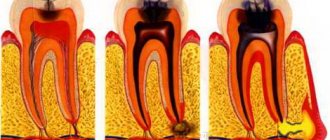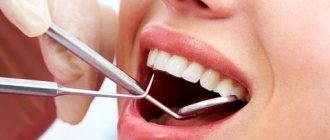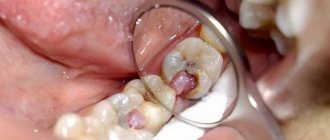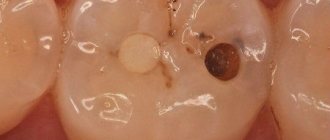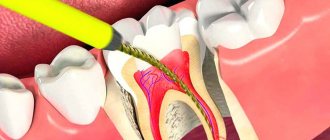February 24, 2020
Some patients, literally a few days after treatment at the dentist, discover that their temporary filling has fallen out. The situation is unpleasant, but not critical, and it is important to know what to do next in order to avoid subsequent complications. The editors of the UltraSmile.ru portal, based on the recommendations of experienced doctors, have prepared material on how to act in this situation, what the consequences of inaction are and whether it is possible to somehow protect yourself from such a problem.
Indications for installing a temporary filling
Some patients are sincerely perplexed and consider temporary filling an unnecessary measure. However, in fact, this is a very important stage in the treatment of teeth affected by deep caries, pulpitis, periodontitis, as well as in the presence of abscesses, cysts and granulomas.
The photo shows a temporary filling
The doctor resorts to temporary filling if it is not possible to carry out treatment in one stage or the inflammation needs to be eliminated. They also resort to a temporary solution while stump inlays and permanent prostheses are created for the patient in the laboratory. The filling serves as protection against external factors and bacteria. It prevents medications and antiseptics from coming out, which are placed inside the root canals and have a therapeutic effect.
“The doctor gave me a temporary filling just to see how the tooth would behave and whether complications would begin after treatment of deep caries. I carried it for about 5 days with severe pain, and then it fell out, after which the doctor said that we would remove the nerve from the tooth...”
Nadezhda, review from yell.ru
A child's filling fell out
And of course, we cannot fail to mention the loss of fillings in children. Caries and its treatment in baby teeth are often complicated by several reasons, including the child’s young age, or fear of the dentist.
Caries on baby teeth develops quite rapidly. That is why hygiene of baby teeth in children should be a high priority. If you really monitor the health of your child’s teeth and follow all the necessary hygiene and preventive measures, then treatment and installation of a filling will not take more than 30-40 minutes.
You can often hear stories about how a doctor cured two teeth for a child in 15 minutes. It should be understood that dental treatment is a rather complex process and requires some time, and each stage must be performed carefully and professionally. Fast work in this case cannot be an indicator of quality and skill. Take care of the health of your children, do not allow yourself to be misled. You have the right to demand from the doctor conscientiousness and honest performance of his work!
How long do you need to wear a temporary filling?
Depending on the goals and clinical situation, it can remain in the oral cavity from 1 day to several months. For example, if arsenic was placed under it, with the help of which the nerve in the tooth is killed, then its removal is carried out within 1 to 7 days after installation.
If the “temporary” was installed to sanitize the canals before permanent filling, to treat an inflammatory process in the roots or in the pulp, then it can stand for several weeks or longer. Moreover, during each subsequent visit to the clinic, the doctor can replace one temporary filling with another, and put fresh medicine inside until the inflammation goes away. Sometimes treatment takes about six months.
What to do if for some reason (due to the patient’s negligence or mistakes made by the doctor) the filling material falls out?
Treatment process
People faced with such a problem are interested in how the tooth will be treated when the filling has fallen out. It all depends on individual characteristics, so it is worth considering the most common situations.
If the carious cavity is too large, it makes no sense to fill it again. The material will not hold and will fall out again after a short time. Therefore, the doctor will suggest alternative methods of eliminating the defect, most likely installing a crown.
If repeated caries occurs, pulpitis or other diseases develop, they must first be cured. The doctor prescribes and carries out all the necessary measures and, after complete recovery, places a new filling. If the filling material falls out of a pulpless tooth, re-filling is often also ineffective. In this case, the specialist will recommend installing a pin.
Methods for restoring the integrity of a tooth depend on its condition, so it is difficult to suggest a treatment plan without a preliminary examination.
Tip #1: Rinse your mouth thoroughly
If a temporary filling came out, then most likely there was a medicine underneath it (preparations based on calcium hydroxide, antibiotics, antiseptics and antimicrobial agents1), the purpose of which was to influence the diseased tooth and its canals from the inside. Under the filling materials there may also be a devitalizing paste based on arsenic.
It is important to rinse your mouth thoroughly
Medicines are covered with temporary materials not only so that they cannot leak out or be washed out by saliva and liquid, but also to protect the body from possible negative effects. For example, the same arsenic is toxic; after ingestion, it can cause poisoning, gastrointestinal upset, an allergic reaction and a rash. If the medicine comes out of the cavity and gets on the mucous membrane, this can lead to tissue irritation or burns.
To prevent the spread of medicinal compounds to the mucous membranes and their ingestion, thoroughly rinse the mouth with any antiseptic solution (for example, Chlorhexidine).
If a temporary filling falls out while eating food, do not swallow the food that was in your mouth at that moment, but rather spit it out.
How can you tell if a filling is about to fall out?
After filling, the material occupies the entire drilled cavity; there are no gaps between it and the tooth tissues. When gaps appear between the filling and the tooth, it wobbles when pressed with the tongue, and you need to consult a doctor to prevent the material from falling out.
If this has already happened, and the patient notices a hole in the problem tooth, you need to act consciously. You cannot seal it with chewing gum or insert cotton wool or other improvised materials into the cavity. It will not be possible to seal the hole hermetically; such measures can only do harm, because this will create favorable conditions for the proliferation of pathogenic microorganisms and the spread of infection.
Tip #2: Don’t rely on recommendations from online forums
A temporary filling has fallen out and you don’t know what to do in this situation? First of all, give up the idea of taking advantage of the dangerous recommendations of some Internet users. Under no circumstances should you do the following:
- cover the resulting cavity with chewing gum: you can introduce infection inside,
- pick out the remains of the filling and the medicine inside with a needle or other sharp objects: there is a high probability of damage to the soft tissues of the oral cavity. During the manipulation, there is a risk of breaking the needle, and it will be impossible to pull out the fragment on your own, which will lead to the development of inflammation. The use of sharp objects is fraught with the exact opposite effect - you will drive deeper the remains of the medicine and bacteria from the external environment,
- put antibiotics or tablets inside yourself: this can increase the pain and worsen the condition of the pulp, dentin and surrounding tissues.
Don't pick your teeth yourself
What to do if a temporary filling falls off?
Modern dentists in practice always adhere to the basic principle - you must try to save the tooth at all costs, and take any possible methods to restore its integrity and functionality, even in cases where the tooth is very problematic. In some rather complex clinical cases, it may take a little longer to cope with them. In such situations, treatment will involve several temporary stages, requiring two or more visits to the dentist. In order to protect the exposed tooth until the next visit to the doctor, a temporary filling will be required.
A temporary filling is usually installed in case of deep caries, when the inflammatory process affects the root canals, as well as in case of pulpitis. Such a filling is a special composition that is used to temporarily close the canals or cavity in the tooth in order to ensure protection and tightness of the opened cavities. At your next visit to the dentist, the temporary filling will be easily removed, after which the doctor will be able to continue to carry out the necessary medical procedures.
At its core, a temporary filling differs from a permanent filling in that it is not able to withstand constant or increased chewing load. Therefore, walking with her for a long time is unacceptable. Upon completion of treatment procedures, the temporary filling must be replaced with a permanent one.
Tip #3: When eating, cover your tooth with cotton and don't chew on it.
Remember that in the absence of a temporary filling, the internal cavity remains defenseless against bacteria and small pieces of food. If food particles get into the root canals, it will be difficult to remove them, they will begin to rot, which will lead to an inflammatory process and the need to re-treat the canals. To protect the tooth from such a problem, before eating food, apply a sterile bandage or a piece of cotton wool to the opened cavity. For the same purpose, try to chew on the opposite side of the jaw.
A temporary filling is not only a “lid” that tightly closes the medicines inside, but also protection from external influences and damage. If the material falls out, the tooth becomes vulnerable, it is susceptible to bacteria and any mechanical stress, and can chip and break off. For this reason, you should also avoid chewing food (especially hard food) on a sore tooth. The thinner the tooth walls and the larger the size of the prepared cavity, the greater the likelihood of tissue destruction.
After each meal, it is important to rinse with antiseptics to “neutralize” bacteria living in the oral cavity and wash away food debris. If this is not done, then after removing the fleece, all this may end up inside an open cavity.
How long can you walk without a filling and what to do if it falls out?
You need to make an appointment with a doctor as soon as possible. This is especially true if the tooth hurts after the filling has fallen out. If you still cannot visit the office, you should follow a number of simple rules before doing so. This will help minimize harm and avoid complications.
- Do not put pressure on the tooth or chew hard foods on it.
- It is better not to chew on a damaged tooth at all.
- The oral cavity can be rinsed with chamomile decoction, soda and saline solutions at a comfortable temperature.
- Be extremely careful when brushing your teeth, do not put a toothpick or other sharp objects into the hole.
During the examination, the dentist will determine the cause of the problem and will be able to eliminate the problem as quickly as possible.
Tip #4: Take pain medication
Immediately after installing a temporary filling, many patients complain of pain. Most often, the pain in the first hours and days is associated with the preparation of tissues and the fact that the medicine put inside has not yet fully worked, has not coped with the inflammatory process, and has not killed the pulp (if a devitalizing composition has been used). But if the material falls out, the pain usually intensifies. To eliminate it, take an analgesic from your home medicine cabinet, such as Nurofen or Ketanov.
Take a painkiller to relieve pain
Under no circumstances place an Aspirin or Analgin tablet into the tooth cavity, as some Internet sources advise! You can cause irritation, swelling and burns of the tissue, which will lead to an even more severe pain reaction.
To reduce pain, you can also use decoctions of chamomile and sage, a solution of soda and salt.
Necessary actions if a filling falls out
It is important to know what to do if a filling falls out. It is advisable to immediately make an appointment with a dentist, but in some cases it is not possible to urgently visit a doctor. When a filling has come out of a tooth, you can do without it for a short time, but only for a certain time.
If treatment is delayed, the tooth may become infected, leading to acute pain and gradual destruction. It is important to visit a specialist in a timely manner, regardless of whether the filling is permanent or temporary.
But it is better to avoid such a situation and visit the dentist at the stage of loosening. Any gap or even minimal gap between the tooth and the filling is a place for bacteria to enter.
And if you don’t pay attention to such a problem in time, then you shouldn’t be surprised that the filling has fallen out between the teeth.
Most often, such troubles occur with molars. They experience a lot of stress and the filling material can be destroyed if you often eat solid foods. Fillings on the front tooth fall out much less frequently.
Tip #5: See a doctor immediately
A temporary filling fell out: what to do? The only right decision is to make an appointment with a doctor as quickly as possible, even if you visited him a few days ago and a return visit was not part of your plans.
Remember, a temporary filling is evidence that the tooth has not yet been fully healed or restored. If it falls out, this increases the risk that you will then have to start a long, expensive treatment all over again or be left without a tooth altogether. If the infection in the root canals is not completely destroyed at the time the temporary material falls out, then it can easily spread to neighboring units and tissues and move through the circulatory or lymphatic system to internal organs.
You should contact your dentist as soon as possible
In the absence of measures, the likelihood of the crown chipping and its complete destruction, injury and damage to the mucous membrane increases (after all, after the materials fall out, the resulting cavity may have sharp edges).
What to do when a filling falls out
Further treatment tactics depend on the patient’s behavior after the temporary filling falls out. If you do not take any action and wait for your appointment, then most likely the doctor will have to re-clean the tooth cavity or even carry out additional procedures to eliminate pathological processes that have arisen due to external factors. An open tooth is accessible to all infections and is highly undesirable at any stage of treatment.
If the filling falls out on the day of installation
In cases where the temporary filling falls out after 2 hours or approximately this time, you must immediately contact a specialist for re-filling.
What should you do if a temporary filling falls out in the evening, when you can no longer visit the dentist? In such a situation, it is necessary to close the cavity. For this, for example, you can purchase a special dentin paste or its analogues at the pharmacy. You should try to remove the remains of the filling, but without using sharp objects, so as not to damage the internal tissues and channels. After this, the cavity is filled with paste, and the next day they are sent to the attending physician.
If it is not possible to purchase such a paste, it is recommended to minimize food intake and constantly rinse your mouth with mouthwash or other antiseptic agents. Rinsing is necessary after each meal to flush out food particles from the exposed tooth that may get into the cavity.
Loss of filling in sealed and unsealed canals
The greatest risk occurs when a temporary filling falls out and the canals are not sealed. Due to the high probability of contamination of the dental canals, the patient should also “seal” the tooth with paste, or rinse the tooth regularly. You can also use a soda solution for rinsing. On the same day or the next day, the patient must go to the clinic to take measures to close the cavity in the crown.
If a temporary filling falls out, but the canals are sealed, what should I do? In such patients, the likelihood of complications is minimal, since neither infection nor foreign particles can penetrate into the canals themselves. But it is still impossible to leave the cavity open, since the crown is weakened and its internal tissues are not protected from mechanical stress. Patients are also advised to rinse as a preventative measure and to see a dentist again, who may even install a permanent filling right away.
Measures to help prevent temporary fillings from falling out
In order not to think about what to do if a temporary filling falls out, try to prevent such a situation after its installation. To do this you need to adhere to the following rules:
- in the first 2 hours after installation, refrain from eating any food so that the materials finally harden and acquire the desired shape,
- exclude hard foods, nuts, and sticky foods from your diet: temporary fillings are softer than permanent fillings, they can easily crumble, break off or fall out,
- try to chew on the side opposite to the one where the treatment was carried out,
- refuse to use irrigator and floss in the area of localization of temporary materials,
- Carefully inspect the seal every day for chips and cracks: if even small leaks appear, you should consult a doctor.
Eliminate solid foods from your diet
As you can see, there is nothing difficult about keeping a temporary filling in place. If it falls out before the scheduled visit to the dentist, then there is nothing to worry about in this situation, provided that you act correctly and do not put off going to the doctor for a long time.
Notice
: Undefined variable: post_id in
/home/c/ch75405/public_html/wp-content/themes/UltraSmile/single-item.php
on line
45 Notice
: Undefined variable: full in
/home/c/ch75405/public_html/wp-content /themes/UltraSmile/single-item.php
on line
46
Rate this article:
( 7 ratings, average: 4.00 out of 5)
dental fillings
- Fedorinchik O.V. Frequency of use of calcium hydroxide preparations by dentists in the treatment of complicated caries. – Modern dentistry, 2011.
Expert “A temporary filling is not intended for long-term use, so if the doctor installs it, he must inform the patient when the next visit to the clinic needs to be made for removal or replacement. But not all people come on the appointed day, some postpone the issue for a week or even longer - and this explains why the integrity and tightness of the material is gradually being compromised.” Dentist-therapist Elena Vladimirovna Orlova
Consulting specialist
Orlova Elena Vladimirovna
Doctor rating: 9.5 out of 10 (2) Specialization: Dentist-therapist Experience: 33 years
Destruction of the seal
Has the filling broken? This is evidence of its gradual destruction. This phenomenon can occur for various reasons. The main ones:
- Too much zeal when carrying out hygiene procedures. Frequent use of a hard brush can cause damage to the filling material or enamel.
- Large loads on the tooth. They occur when eating solid foods, seeds, nuts and the like.
- Poor quality filling material.
- Failure of a specialist to comply with the technological process.
What to do if a piece of the filling breaks off and your tooth hurts? This indicates that the material does not adhere tightly to the surface and a gap has arisen between the filling and the tooth. Pain is a consequence of the inflammatory process. If the pathology is not eliminated, it will develop and cause various diseases.
If a filling breaks on a dead tooth, a crown will have to be placed in any case. If a problem arises on a front tooth that is still alive, the doctor will suggest depulping it and then installing a crown as well.
Comments
The doctor recently put in a temporary filling, told me to come back only in a week, but the tooth underneath it hurts very much, I can’t stand it, I’m very, very nervous... Is it possible to somehow pull it out ahead of time?
Kira (03/02/2020 at 00:55) Reply to comment
- Dear Kira, pain after installing a temporary filling can indicate both a pathological process and be a normal tissue reaction to the intervention. In both cases, you cannot try to remove the filling yourself, but it is not forbidden to visit a doctor unscheduled - the specialist will determine the true cause of the pain, and you will stop being nervous.
Editorial staff of the portal UltraSmile.ru (03/11/2020 at 09:04) Reply to comment
If you followed all the recommendations of your dentist, but the temporary filling still fell out, then this is a reason to think about changing your dentist. I think so. Where is the guarantee that he will then install the permanent one poorly?
Pavel (03/20/2020 at 10:07 am) Reply to comment
Good afternoon I once had a tooth crumble and its treatment took several days. They gave me a temporary filling and told me not to eat for several hours so that everything would harden. The remains of the tooth did not hurt under the temporary filling, since my nerve was removed, but if they put a temporary filling on the tooth where caries was treated, how to avoid pain?
Dmitry Ch. (03/20/2020 at 11:29 am) Reply to comment
At the appointment, the doctor began treatment and placed a temporary filling. The next visit was scheduled in five days. But the tooth began to bother me in the evening after visiting the doctor. Tell me if you need to see a doctor earlier than the appointed day
Svetlana (03/20/2020 at 11:56 am) Reply to comment
Tell me, if the temporary filling fell out over the weekend and my doctor doesn’t have an appointment for the next few days, will I have to walk around with cotton wool in my tooth? Maybe there is some special remedy for the time being?
Maria K (03/20/2020 at 12:12 pm) Reply to comment
My son is 10 years old. They put a temporary filling with medicine, the doctor told me to come back in 10 days. 5 days have passed, the tooth hurts. What should we do when we go to remove the tooth?
Tatyana (03/20/2020 at 01:03 pm) Reply to comment
Hello. I would like to know the opinion of a professional, because different doctors answer my question differently. Back in the days of the Soviet Union, I was given a filling. It does not have a very aesthetic appearance, it is dark in color and those who are not in the know always point out to me that the tooth needs to be treated. Do you think it’s worth changing it if the tooth itself doesn’t bother you and the filling is done, as they say, to last forever. Or is there some modern way to simply cover up the color of the filling? Best regards, Asya.
Asya (03/20/2020 at 14:01) Reply to comment
This is terrible, I swallowed a temporary filling, what will happen now?
Tatyana (03/22/2020 at 06:14 pm) Reply to comment
- Modern filling materials are safe and, if swallowed, do not cause serious consequences for the body. But the medications that are under them can provoke irritation and upset of the gastrointestinal tract, and an allergic reaction. But in any case, there is no need to be nervous, because the dose of medications is small, they cannot cause serious harm to an adult body. To neutralize the negative effects of medications, you can take Polysorb and an antihistamine (for example, Zodak). Also be sure to contact your dentist to have the filling reinstalled or a permanent restoration done if necessary.
Editorial staff of the portal UltraSmile.ru (03/27/2020 at 09:27) Reply to comment
Good afternoon Please tell me, four days ago I got a temporary filling. At first everything was fine, but a couple of days ago my tooth started to hurt horribly. I called the clinic and they told me that there was nothing wrong with it and that you would come for an appointment in 6 days. I wanted to know if this is normal or is it better to go to another doctor? Because I don’t understand anything at all about dentistry.
Yana (04/23/2020 at 07:42) Reply to comment
Please specify what is the maximum service life of a temporary filling? My husband was given a temporary filling and an appointment was scheduled for only a month later. Now I’m worried whether wearing it for such a long time will have a negative impact, because about ten years ago my colleague delayed her visit to the dentist after installing a temporary filling, which led to tooth extraction.
Victoria (04/23/2020 at 07:53) Reply to comment
Why does a temporary filling still fall out, even if the patient was careful and followed the dentist’s advice? Maybe, among other things, there is some kind of rejection by the body of the materials that make up its composition?
Dmitry (04/23/2020 at 08:56) Reply to comment
Hello, what could be the reasons for a temporary filling falling out? Unprofessionalism of the doctor? Or something else more significant? Is it true that a temporary filling is harmful to the body?
Mikhail (04/23/2020 at 09:09) Reply to comment
Write your comment Cancel reply
Filling falling out during pregnancy
When a temporary filling falls out during pregnancy, this is a reason to urgently consult a dentist. Many women worry that treatment may negatively affect the course of pregnancy. Women carrying a child are certainly at risk, but doctors are well aware of the acceptable limits of exposure. If necessary, the doctor will select the optimal method of intervention so as not to harm the body.
You need to treat your teeth anyway. Carious lesions are an ideal environment for the development of pathogens that can cause much more harm to a pregnant woman than the process of restoring a diseased tooth.
If a filling falls out at the end of pregnancy - in the 3rd trimester, the doctor may postpone treatment if serious intervention is necessary to restore the tooth. In most cases, the specialist will make do with minimal temporary treatment, and will carry out complex measures carried out under anesthesia after childbirth.


